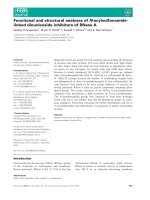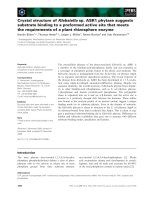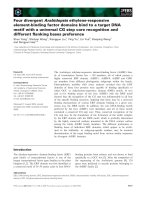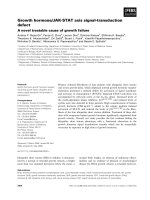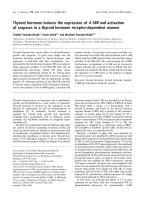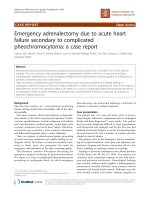báo cáo khoa học: "Thyroid-stimulating hormone elevation misdiagnosed as subclinical hypothyroidism following non-convulsive status epilepticus: a case report" ppt
Bạn đang xem bản rút gọn của tài liệu. Xem và tải ngay bản đầy đủ của tài liệu tại đây (1.1 MB, 5 trang )
CAS E REP O R T Open Access
Thyroid-stimulating hormone elevation
misdiagnosed as subclinical hypothyroidism
following non-convulsive status epilepticus:
a case report
Akira Wada
1*
, Yoshiaki Suzuki
2
, Sanae Midorikawa
3
, Satoshi Takeuchi
1
, Yasuto Kunii
1
, Hirooki Yabe
1
and
Shin-Ichi Niwa
1
Abstract
Introduction: Non-convulsive status epilepticus is a form of epileptic seizure that occurs without convulsions.
Recent reviews suggest that the diagnosis of non-convulsive status epilepticus remains difficult. Here, we report
the case of a patient with thyroid-stimulating hormone elevation misdiagnosed as subclinical hypothyroidism
following non-convulsive status epilepticus.
Case presentation: Our patient was a 68-year-old Japanese woman. The results of endocrine testing after her first
episode of non-convulsive status epilepticus suggested latent subclinical hypothyroidism: she had elevated thyroid-
stimulating hormone with normal levels of free tri-iodothyronine and free thyroxine. On examination, a diagnosis
of thyroid disorder was not supported by other test results and our patient remained untreated. A follow-up
examination revealed that her thyroid-stimulating hormone levels had spontaneously normalized. When she
consulted another doctor for confusion, the transient increase in thyroid-stimulating hormone levels following non-
convulsive status epilepticus was mistaken for subclinical hypothyroidism, and unfortunately treated with
levothyroxine. Our patient then experienced levothyroxine-induced non-convulsive status epilepticus.
Conclusions: In this report, we suggested possible mechanisms for latent hypothyroid-like hormone abnormality
following epileptic seizures and the possibility of provoking epileptic seizures by administering levothyroxine for
misdiagnosed subclinical hypothyroidism.
Introduction
Non-conv ulsive status epilepticu s (NCSE) is a condition
primarily diagnosed through electroencephal ography
(EEG). The differentiation of NCSE from other neurolo-
gical and psychiatric disorders is necessary because of
possible damage to many high-order functions including
consciousness, emotion, thinking, and memory. Absence
epilepsy was first described by Lennox in 1945 [1], and
Gastaut and Roger reported non-convulsive complex
partial status epilepticus in 1956 [2]. Since then, these
seizures and the associated neurolog ical sympt oms have
been found to be linked, and it is now possible to
determine whether they are paroxysmal or non-paroxys-
mal. A recent review suggested that the diagnosis of
NCSE remains difficult, and a high index of suspicion is
required to recognize and correctly diagnose this illusive
condition [3]. NCSE is a rare condition, reportedly
affecting only 38 people per 100,000; however, the true
incidence may be much hig her [4]. Although NCSE pre-
sents with various symptoms, it is much more difficult
to distinguish NCSE onset compared to convulsive
epilepsy.
In our patient, we observed transient thyroid-stimulat-
ing hormone (TSH) elevation following NCSE that was
misdiagnosed as subclinical hypothyroidism. After
admini stration of levothyroxine, our patient experienced
levothyroxine-induced NCSE. In the present report, we
consider the possibility of TSH elevation following
* Correspondence:
1
Department of Neuropsychiatry, Fukushima Medical University School of
Medicine, Fukushima, Japan
Full list of author information is available at the end of the article
Wada et al. Journal of Medical Case Reports 2011, 5:432
/>JOURNAL OF MEDICAL
CASE REPORTS
© 2011 Wada et al; licensee BioMed Central Ltd. This is an Open Access article distributed u nder the terms of the Creative Commons
Attribution License ( which permits unrestricted use, di stribution, and reproduction in
any medium, provided the original work is properly cited.
NCSE, and the possibility of levothyroxine superindu-
cing NCSE.
Case presentation
Our patient was a 68-year-old Japanese woman who
had no history of major illness. Nine years before her
admission, she had been taking daily triazolam pre-
scribed by a local doctor for insomnia, and four years
before admission, she attempted to sleep without tak-
ing this medication but was unable to. The next day,
her conversation was unfocused and she was unable to
relax. She was examined at our hospital’ sneurology
department on the same day. Our patient seemed nor-
mal in appearance and showed no signs of automatism
or convulsions. However, she exhibited marked disor-
ientation and a euphoric mood. Her free tri-iodothyro-
nine and free thyroxine (fT3 and fT4, respectively)
levels were normal but her TSH levels were high
(10.88 μIU/mL), and she was accordingly admitted to
the neurology department with suspected Hashimoto’s
encephalopathy. However, our patient tested negative
for anti-thyroid antibodies (A-TPO: Anti-Thyroid per-
oxidase, A-TG: Anti-Thyroglobulin, and A-MC: Anti-
Microsome), her cerebrospinal fluid appeared normal,
and there were no a bnormalities on a thyroid ultra-
sound scan; therefore, her results did not support the
diagnosis of Hashimoto’ s encephalopathy. Her EEG
results showed continuous, irregular, generalized 3 Hz
spike-and-wave complexes, and our patient was
accordingly diagnosed as h aving NCSE (absence status
epilepticus). After administration of 5 mg of diazepam
intravenously, the 3 Hz spike-and-wave complexes dis-
appeared. The next day, her orientation improved. She
was discharged after 11 days and began taking zonisa-
mide (200 mg/day).
Three years before admission, she experienced depres-
sion, which resolved with flunitrazepam alone. One year
before admission, because her speech was slightly con-
fused, she was investigated at an internal medicine clinic
and was found to have a TSH level of 5.7 μIU/mL and
an fT4 level of 1.0 ng/dL. At this time, our patient was
diagnosed as having subclinical hypothyroidism and
given 25 μg/day of levothyroxine. However, she did not
adhere to this medication until 12 days before this
admission.
Our patient ’s husband became concerned because our
patient, who was always methodical in her behavior, was
forgetting to close gas valves and switch off the lights.
Our patient was examined at our facility and reported
having circumstantial thinking, but no other neurologi-
cal symptoms. However, she was unable to remember
her behavior from that morning. We suspected that our
patient was suffering from a mild deterioration o f con-
sciousness and performed an EEG. This showed
continuous 3 to 5 Hz polyspike-and-wave complexes
(Figure 1A), and our patient was hospitalized with
NCSE.
On admission, a physical examination r evealed no
non-pitting edema, or any irregularities in the central
nervous system, motor system, sense of balance, reflexes,
sensory systems, or in the head, neck, or spine. Her bio-
chemical and hematological findings were unremarkable.
Endocrine analysis revealed the following: TSH 11.19
μIU/mL,fT41.04ng/dL,fT32.61pg/mLandprolactin
(PRL) 30.74 ng/mL (her TSH and PRL levels were
hence considerably elevated). A cranial MRI scan
showed no gross lesions, and a pituitary MRI scan
revealed no tumors. After admission, we supplemented
her medication with a 10 mg/day diazepam suppository
and 0.5 mg/day of oral clonazepam . Our patient’s level
of consciousness had greatly improved by the next day
after this admission, and all evidence of paroxysmal dis-
charge had disappeared (Figure 1B). Four days after this
admission, further endocrine testing results showed nor-
mal levels of TSH (3.575 μIU/mL) and her PRL level
had fallen (16.18 ng/mL). To determine the cause of the
high TSH levels detected on admission, thorough endo-
crine examinations including thyroid ultrasound and
anti-thyroid antibody tests were performed at our Divi-
sion of Endocrinology, but there was no evidence of
thyroid disorder. We therefore decided that in the
absence of thyroid disorder, and because of the potential
for further NCSE episodes, our patie nt did not require
levothyroxine. Our patient was discharged from our
department 12 days after this admission. There have
been no further signs of NCSE recurrence to date.
Discussion
In our patient, endocrine testing revealed elevated TSH
levels associated with NCSE while fT3 and fT4 levels
remained normal. However, thyroid function tests per-
formed after both episodes (unquestionably NCSE)
showed no evidence of a thyroid disorder. Our patient
was monitored without further treatment and her TSH
levels normalized (Figure 2). The details of pathogenesis
areunknown;webelievethattheetiologyofthefirst
episode of NCSE might be the intermittent use of tria-
zolam. During the course of her illness, our p atient
showed confusion and was unfortunately misdiagnosed
as having subclinical hypothyroidism based on findings
of endocrine testing at another clinic and was adminis-
tered levothyroxine. The episode of NCSE a year before
this admission was induced without levothyroxine. Non-
compliance with zonisamide medication, inadequate
therapeutic levels of the zonisamide medication, and the
intermittent use of benzodiazepines may have exacer-
bated this NCSE recurrence. However, the etiology of
the NCSE recurrence on the day our patient was
Wada et al. Journal of Medical Case Reports 2011, 5:432
/>Page 2 of 5
Figure 1 Electroencephalograms taken on the first (A) and second day (B) of hospitalization. On the first day of hospitalization, a general
absence of normal brain waves with continuous irregular 3 Hz to 5 Hz spike-and-wave complexes is apparent. On the second day of
hospitalization, a large number of alpha waves with a basic frequency of 10 Hz were seen, predominantly in the occipital area. There was no
evidence of paroxysms.
Wada et al. Journal of Medical Case Reports 2011, 5:432
/>Page 3 of 5
hospitalized in our department was also uncertain, and
may have occurred after prescribing levothyroxine. We
hypothesize that the high TSH levels were caused b y
NCSE, and that levothyroxine induced NCSE
recurrence.
Several cases have been reported where e pileptic dis-
charges induced endocrin e abnormalities. Prolactin has
been reported to increase following epileptic seizures
[5], as have TSH levels. Apria et al. [6] reported that the
pituitary gland can suddenly release TSH following elec-
troconvulsive therapy. In addition, it is reported that
ictal epileptic activity in the mesial temporal structures
may propagate to the hypothalamus [7]. Our patient had
diffuse electrical discharges in the brain including the
bilateral temporal lobe (Figure 1A), therefore NCSE
might feasibly have induced elevation of TSH and PRL
levels.
However, it should be verified whether physicians with
little experience of NCSE are likely to start levothyrox-
ine when they encounter patients whose laboratory data
are similar to the findings from our patien t. A review of
studies on la tent thyroid disorder by Surks et al. recom-
mended treatment with levothyroxine for women aged
60 and older with TSH levels in the 4.5 to 10 μIU/mL
range [8]. This recommendation strongly supports the
decision to use levothyroxine in our patient’s case. How-
ever, though NCSE is rare, if it can induce abnormal
levels of TSH, it is important to evaluate cognitive
symptoms in detail.
In addition, there are several reports propo sing a
negative correlation between thyroid function and epi-
leptic threshold. Jabbari and Huott reported a case of
concurrent hyperthyroidism and epileptic seizure; as
thy roid function improved, so did epileptic seizures and
abnormal brain wave patterns [9]. Maeda and Izumi
reported on a patient who developed generalized con-
vulsions emerging concurrently with Graves’ disease
[10].Inthecaseofourpatient,therefore,itseemsthat
levothyroxine likely lowered the epileptic threshold,
which provoked the NCSE before our patient was
admitted to our department.
NCSE-induced hormone abnormality resulting in
TSH elevation with normal fT3 and fT4 levels may be
misdiagnosed as subclinical hypothyroidism. Particular
attention is required because treatment of subclinical
hypothyroidism with levothyroxine may result in a
4 years before
this admission
1 year before
this admission
This admission
Figure 2 Thyroid hormone and prolactin levels over the cour se of the illness and follow-up. Arrows indicate the dates on which non-
convulsive status epilepticus (NCSE) was confirmed by electroencephalography. Broken arrows indicate dates of possible NCSE identified by
clinical factors but not confirmed through electroencephalography. The black square at the top of the figure indicates the period in which
levothyroxine was taken.
Wada et al. Journal of Medical Case Reports 2011, 5:432
/>Page 4 of 5
lowered epileptic threshold and consequent NCSE
recurrence. Because some cases presenting with a high
TSH with normal fT3 and fT4 levels may have NCSE
as an underlying cause, particular caution is necessary
when interpreting these particular endocrine
abnormalities.
Conclusions
We present a case of TSH elevation misdiagnosed as
subclinical hypothyroidism following non-convulsive sta-
tus epilepticus. In this case report, we suggested the
possible mechanisms of latent hypothyroid-like hormone
abnormality following epileptic seizures and the possibi-
lity of provoking epileptic seizures by administering
levothyroxine for misdiagnosed subclinical
hypothyroidism.
Consent
Written informed consent was obtained from the patient
for publication of this case report and any accompany-
ing images. A copy of the written consent is available
for review by the Editor-in-Chief of this journal.
Author details
1
Department of Neuropsychiatry, Fukushima Medical University School of
Medicine, Fukushima, Japan.
2
Shimizu Hospital, Fukushima, Japan.
3
Department of Nephrology, Hypertension, Endocrinology and Metabolism,
Fukushima Medical University School of Medicine, Fukushima, Japan.
Authors’ contributions
AW wrote the first draft of the manuscript. YS, ST, YK, HY, and SN provided
helpful comments on the draft of this paper from a psychiatrist’s viewpoint.
SM provided helpful comments on the draft of this paper from an
endocrinologist’s viewpoint. All authors read and approved the final
manuscript.
Competing interests
The authors declare that they have no competing interests.
Received: 25 April 2011 Accepted: 5 September 2011
Published: 5 September 2011
References
1. Lennox WG: The treatment of epilepsy. Med Clin North Am 1945,
29:1114-1128.
2. Gastaut H, Roger A: Sur la signification de certaines fugues épileptiques:
état de mal temporal [in French]. Rev Neurol 1956, 94:298-301.
3. Epstein D, Diu E, Abeysekera T, Kam D, Chan Y: Review of non-convulsive
status epilepticus and an illustrative case history manifesting as
delirium. Australas J Ageing 2009, 28:110-115.
4. Waterhouse EJ, DeLorenzo RJ: Status epilepticus in older patients:
epidemiology and treatment options. Drugs Aging 2001, 18:133-142.
5. Trimble MR: Serum prolactin in epilepsy and hysteria. Br Med J 1978,
16:1682.
6. Aperia B, Bergman H, Engelbrektson K, Thoren M, Watterberg L: Effects of
electroconvulsive therapy on neuropsychological function and
circulating levels of ACTH, cortisol, prolactin, and TSH in patients with
major depressive illness. Acta Psychiatr Scand 1985, 72:536-541.
7. Parra A, Velasco M, Cervantes C, Muñoz H, Cerbón MA, Velasco F: Plasma
prolactin increase following electric stimulation of the amygdala in
humans. Neuroendocrinology 1980, 31:60-65.
8. Surks MI, Ortiz E, Daniels GH, Sawin CT, Col NF, Cobin RH, Franklyn JA,
Hershman JM, Burman KD, Denke MA, Gorman C, Cooper RS, Weissman NJ:
Subclinical thyroid disease: scientific review and guidelines for diagnosis
and management. JAMA 2004, 291:228-238.
9. Jabbari B, Huott AD: Seizures in thyrotoxicosis. Epilepsia 1980, 21:91-96.
10. Maeda T, Izumi T: Generalized convulsions with diffuse spike and wave
bursts emerging with Graves’ disease. Neuropediatrics 2006, 37:305-307.
doi:10.1186/1752-1947-5-432
Cite this article as: Wada et al.: Thyroid-stimulating hormone elevation
misdiagnosed as subclinical hypothyroidism following non-convulsive
status epilepticus: a case report. Journal of Medical Case Reports 2011
5:432.
Submit your next manuscript to BioMed Central
and take full advantage of:
• Convenient online submission
• Thorough peer review
• No space constraints or color figure charges
• Immediate publication on acceptance
• Inclusion in PubMed, CAS, Scopus and Google Scholar
• Research which is freely available for redistribution
Submit your manuscript at
www.biomedcentral.com/submit
Wada et al. Journal of Medical Case Reports 2011, 5:432
/>Page 5 of 5
